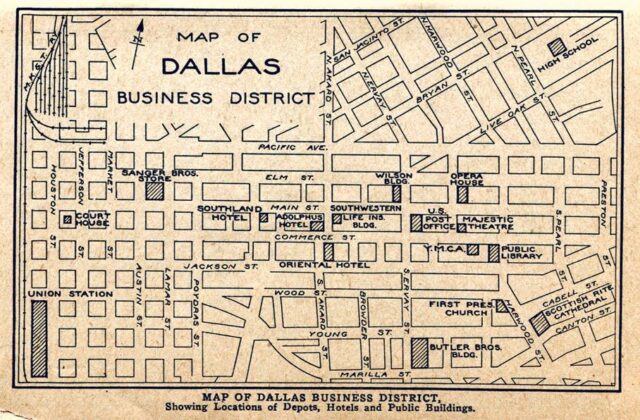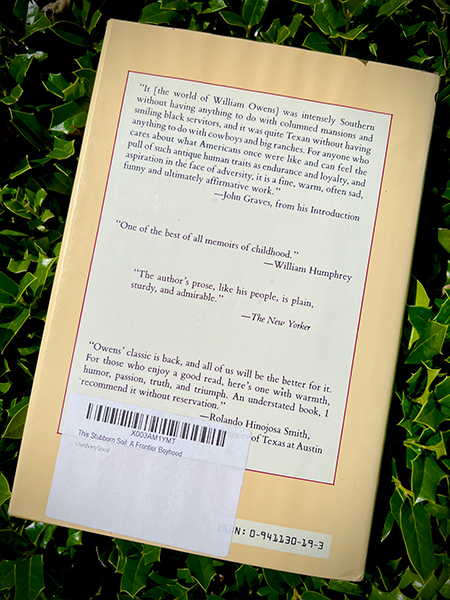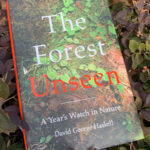
We are big fans of Texana here on this website—especially DFW area Texana. When it comes to the history of North Texas, This Stubborn Soil by William A. Owens (copyright 1966, 1986) checks a lot of important boxes. This wonderful book is set in Pin Hook—just a few mile east of Paris, Texas, and only about 112 miles northeast of the Dallas/Fort Worth. The autobiography tells the story of the author’s childhood in rural North Central Texas during the early part of the last century.
William Owens was born in 1905. His father had come down with some unnamed affliction just days before William’s birth and he passed away from the illness shortly afterwards. The responsibility for managing the household and providing for the family was suddenly and unceremoniously thrust upon his mother. She was aided in this endeavor by an ever shifting group of other adult women from the extended family. This was a harsh reality in the early 1900’s, and as you might imagine, there were many trials and tribulations in store for this frontier family.
At the time of his birth, William had four siblings; three brothers and a sister who was the next youngest. His mother—a strong and intrepid frontier woman—struggled mightily to keep the family together and provided for.

The accounts of life in Texas 100 years ago included in this book are fascinating to read. The description of turn of the century Pin Hook and the surrounding communities are vivid and illuminating. If you have ever driven a backcountry road in North Texas, and wondered about how things came to be, this book can offer some important insights.
Today, Pin Hook is little more than a named place on the map—an unincorporated area with a population of only 50 people, or so. But in the early 1900’s, the small settlement supported a sizable community of farmers with an infrastructure that included two cotton gins, several stores, a gristmill, and a blacksmith shop.
The author relates many stories about scratching out a living in this small frontier town. But there was also time for amusements. Holidays were special times. The celebrations were modest, but very special to the participants.
Pin Hook in 1905
The Pin Hook I was born in was still a part of the frontier. The last Indian raid in Texas was only twenty years back and as fresh as yesterday in the mind of the people. Tales of the frontier were a part of daily life. So were the tales of the war between the sections and that greatest of all heroes, Jesse James.
This Stubborn Soil by Willian A. Owens – page 4
One of my favorite chapters describes the excitement surround the circus coming to town. The festivities included a parade down the main thoroughfare as a prelude to the real show under the big top. William and his siblings were there for the procession, but the actual circus was a little too much of an extravagance for his family to be able to attend.
Another time, a traveling salesman arrived at the Owen’s home with a piano loaded on the back of his wagon. The salesman persuaded mother to allow him to bring the piano into the house so that they could try it out. Many songs were played and a good time was had by all. I was amazed while reading this chapter. Amazed that they invited the salesman into their home. Amazed that the destitute family even considered a purchase of this magnitude. I won’t reveal all the details of how this story ultimately played out, but I can tell you it ended up as a great testament to the importance of music and entertainment in people’s lives.
The world was a much larger place in the early 1900s. Reading about the family’s wonderment at the size and amenities of nearby Paris, Texas might leave you with the impression the author was describing Paris, France instead. Paris, Texas—then and now—is the seat of Lamar County, and with a modern population of around 24,000 souls, it is still fair to characterize the community as a relatively small town.
The author had an innate understanding of the value of schooling, and he actively sought out opportunities to pursue education starting from a very young age. But quality instruction was not easy to come by in rural North Texas at the time, and his schooling only progressed in fits and starts. His mother too understood the advantages that would come with education, and she did her best to support her children’s efforts. But in those days, running the homestead and tending crops always demanded priority, and the children were often needed to assist in the never-ending work.
School Admission in the Early 1900s
My mother was certain the law was wrong that kept me out of school till I was eight years old. By rights, I should have been through the primer and first grade. The way to make up lost time, she decided was to put me in second grade with Cleaver, who had been in school for three years, or parts of three years. She was sure the teacher would keep me once she heard me count and multiply and read.
This Stubborn Soil by Willian A. Owens – page 86
Of particular interest were the accounts of student misbehavior during one year of the author’s time at school. The troubles became so severe that they began to seriously hamper the teacher’s ability to do his job. To make matters worse, the parents were inclined to side with their children over the teacher when it came to addressing classroom discipline, and the situation continued its downward spiral. Ultimately, the teacher lost control of the classroom and had no other choice but to resign. It was fascinating to read about what I would have considered a contemporary issue, being in many ways much worse in this small classroom than anything I have witnessed in modern schools.
As the years progressed, news from the outside world would trickle into the Owens’ household. World War One was seemingly a world away until the author’s oldest brother received his draft notice and was instructed to report to Paris, Texas for further instruction. The family was full of trepidations about their eldest son’s fate, but they nonetheless put together a grand party in his honor the day before he was to report for duty. The odd turn of events that followed are more than enough to make the book worth reading.
A short time later the Spanish Flu Pandemic, that followed the end of the war, made its way to the little community of Pin Hook. The telling of its story is particularly relevant and poignant in light of the modern day COVID pandemic we are still enduring.
The Spanish Flu Pandemic
The war was over but the sickness it left behind was a worse killer than the war. It was influenza and it spread from town to town, with newspapers carrying lists of dead on front pages. Then it spread to the country, along country roads, traveling from house to house, scattering death whenever it went. No one knew how to stop it; everyone tried something.
This Stubborn Soil by Willian A. Owens – page 199
As the author reached his teen years, he began to develop a wanderlust. Frustrated with his inability to pursue an education, he decided to seek his fortune 112 miles away in Dallas, Texas. Once again it was engrossing to hear the descriptions of Dallas as a place that was larger than life. With a population of around 160,000 people at the time, Dallas was easily the largest city in close proximity to Pin Hook. I can only imagine the author’s awe as he saw it for the first time.
Seeing Dallas for the First Time
Then I could see the Union Station, white and clean against a blue-gold sky. Then I saw more, enough to make me know Dallas was what I wanted: automobiles on the Viaduct, streetcars coming and going to Oak Cliff, and high above the city, an airplane circling. I had to be a long way from Pin Hook to see so many things all at once.
This Stubborn Soil by Willian A. Owens – page 238
In Dallas, the author took a warehouse job with Sears and Roebucks filling catalog orders. His descriptions of his life in the city are engaging reading. Many modern Dallasites will still recognize many of the streets, neighborhoods, and buildings that he mentions.
But adjusting to city life was a challenge for young William, and over the next several years he came and went; spending some time with his family in Pin Hook and returning to Dallas for work when he could. Through it all, William remained on the lookout for some way—any way—to further his education.



Click to Enlarge
The book ends with the author making his way to Commerce, Texas with the hopes of gaining admittance to East Texas State Normal College. With only the equivalent of an eighth grade education under his belt, the odds were definitely stacked against him. The author’s story is continued in his sequel, A Season of Weathering—a book I will be reading just a soon as I can fit it in!
For those who are interested, East Texas State Normal College is now Texas A&M University – Commerce. The school has been through many iterations since its founding. Here’s a brief history…
- East Texas Normal College (1889-1917)
- East Texas State Normal College (1917-1923)
- East Texas State Teachers College (1923-1957)
- East Texas State College (1957-1965)
- East Texas State University (1965-1996)

So, now let’s get down to the brass tacks and compile a score based on the following rating criteria…
- Accessible, Enjoyable Read – This book was a pleasure to read and is rightfully considered a classic. SCORE: FULL STAR
- Informative, Relevant, Insightful – The book has everything you would hope for in a historical text. It will be especially pertinent for readers living in North Central Texas. SCORE: FULL STAR
- Read Again, Add to Personal Library – I will definitely read this book again, and a copy is going into my personal library. SCORE: FULL STAR
- Availability, Price Point – The book is out of print. Used copies are available in paperback and hardback at various price points, most of which will be under $20, depending upon the book’s condition. SCORE: FULL STAR
- Recommend – This is an easy book to recommend to anyone interested in the history of North Central Texas. SCORE: FULL STAR
RATING: Five out of Five Stars

Further Reading…
- Texas State Historical Association: Owens, William A. (1905-1990)





Chris, thank you for sharing this book review. Owen’s life was amazing, and without revealing details in _A Season of Weathering_, you already know that despite a scant precollege education, he was able to earn a Ph.D. (cultural anthropology) and become a dean at Columbia University. Another thing of importance to me about Owen’s childhood at Pinhook is that his life there would have been very much like that of both of my parents who grew up on hardscrabble farms just 30 miles from Pinhook but across the Red River in Oklahoma.
Another point of interest I found in Owen’s early life was a bit of natural history. His brother brought home a fish to the family table, a bowfin (_Amia calva_) that he had caught by hand in a local wetland or bayou that they called a “slough.” The fish they called a “grindle.” William himself then tried his hand (at 7 years old) at hand fishing, and had an encounter with a large snake, which could have been a water snake, but that he thought was a cottonmouth (water moccasin).
Owen’s was a cultural anthropologist who was expert on Texas folk music and the culture of Texas African-Americans as well as an author of other notable books. Indeed, he is one of my favorite Texas authors.
And indeed, I will go to my bookshelf and retrieve my copy, read multiple times now over the past 25 years that I have possessed it, and read it again. Thanks again Chris, for reminding me of it.
What a great review! I’m off to hunt down a copy.
Texacana??? I think you meant Texana
Yes! Thanks!
Chris, is there a reason you either posted a photo of North Texas State Normal College rather than East Texas State Normal College? Or is the photo incorrectly captioned?
BTW, another point of interest regarding Owen’s education. When he applied to East Texas State Normal College, practicing teachers who mostly had no particular credential were being required to enter colleges and take credentials, for the first time in Texas. Owen’s, who had little formal schooling, passed the entrance exam readily. Many of the practicing teachers did not
Hi David. It was miscaptioned. Thanks for the correction. And thanks also for the additional endorsements of Owen’s story. I hope many people get to enjoy this book. I am currently a little more than half way through his follow up book, “A Season of Weathering.” Also well worth the read!